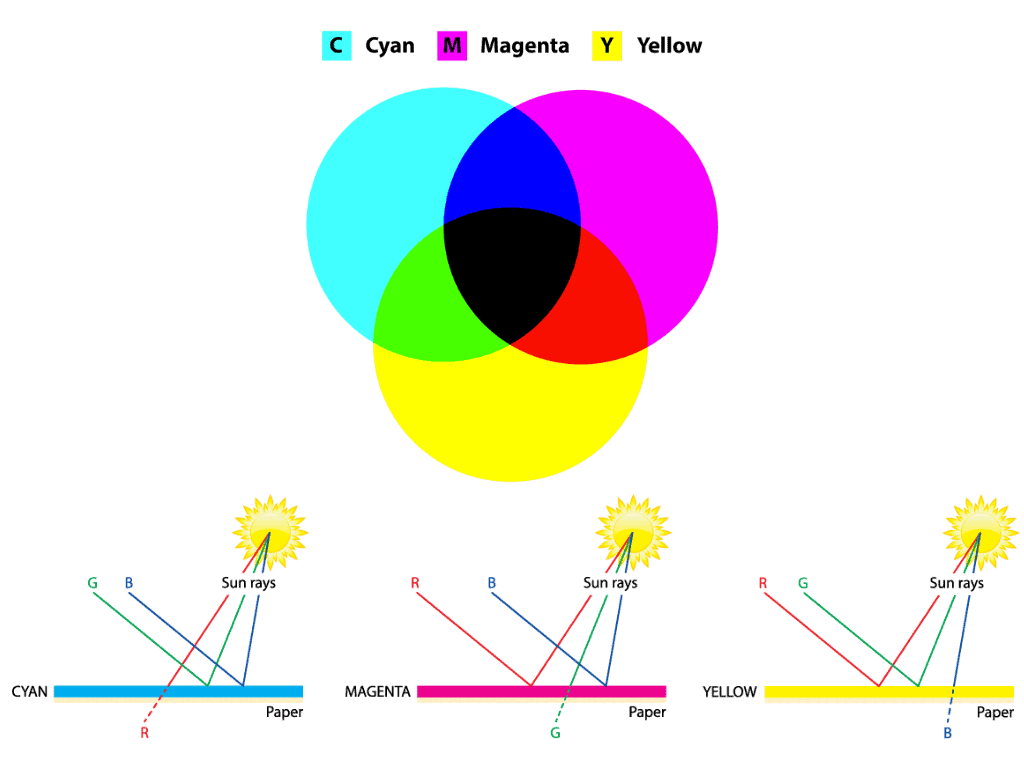Subtractive color theory involves the mixing of pigments, where color is generated by selectively absorbing certain colors from white light while reflecting others.
But why is it called “subtractive,” and what does it actually mean? The term “subtractive” directly relates to how this process generates colors, highlighting the method of color creation.
Like additive color, subtractive color mixes wavelengths of light. However, instead of emitting light, it absorbs (or subtracts) certain wavelengths.
Thus, any paint or pigment absorbs (or subtracts) specific wavelengths of light and reflects the others. The wavelengths of light are associated with additive primary colors: red, green, and blue.
So, subtractive color contrasts with the additive color model, where colors are created by adding different wavelengths of light together.
What is Subtractive Color?
Subtractive color refers to the way pigments, like paints or inks, create color by subtracting (absorbing) parts of the white light spectrum and reflecting the rest.
Unlike the additive color theory, which deals with light itself, subtractive color theory is about how pigments subtract (hence the name) specific wavelengths of light or additive colors from white light.
There are two primary color mixing types: additive, which uses the RGB color model, and subtractive, which uses the CMY color model.
Additive color begins with black (no light), adding light to create a visible spectrum of color.
Adding more light makes the color lighter. Finally, it ends with white when all the additive primaries are combined.
The additive color models are used in digital devices.
Subtractive color starts with white (paper), and once you add pigment, it subtracts light to create color. Mixing more colors results in a darker color.
It’s called subtractive because dyes and pigments subtract (absorb) light rather than emit light.
Subtractive Color Theory
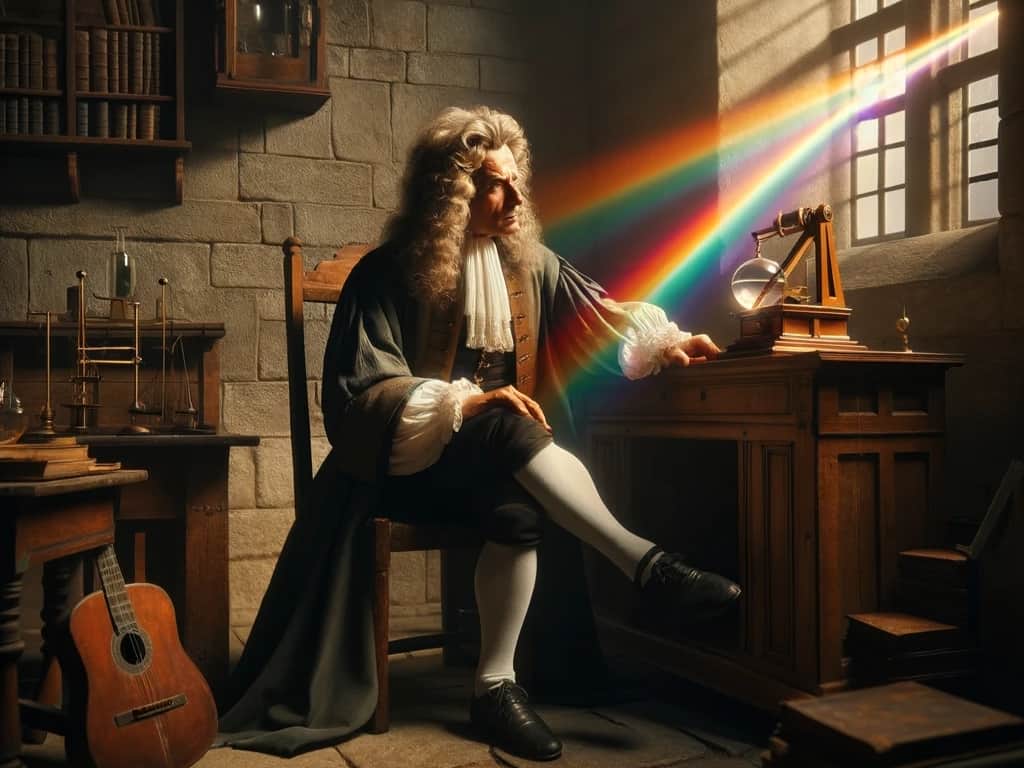
Our understanding of colors started with Sir Isaac Newton in 1672. He was the first person who developed a color theory based on a color wheel. Before him, people thought colors came from mixing light with darkness and that prisms added colors to light.
However, Newton demonstrated that colors come from light itself. He used a prism to break white light into the rainbow colors: red, orange, yellow, green, blue, indigo, and violet. He also showed that the prism wasn’t creating colors by refracting and merging them back into white light.
Light behaves like a wave. It has a frequency, which is how fast it vibrates, and a wavelength, the distance between the peaks or the highest points of the wave.
Frequency and wavelength are opposites; when one is high, the other is low.
Our eyes only see light that vibrates within a specific range, from about 380 to 700 nanometers. You can refer to this range as visible light or visible spectrum.
Colors are waves of light with specific frequencies within the visible spectrum. You can divide the visible spectrum into three parts in terms of wavelengths:
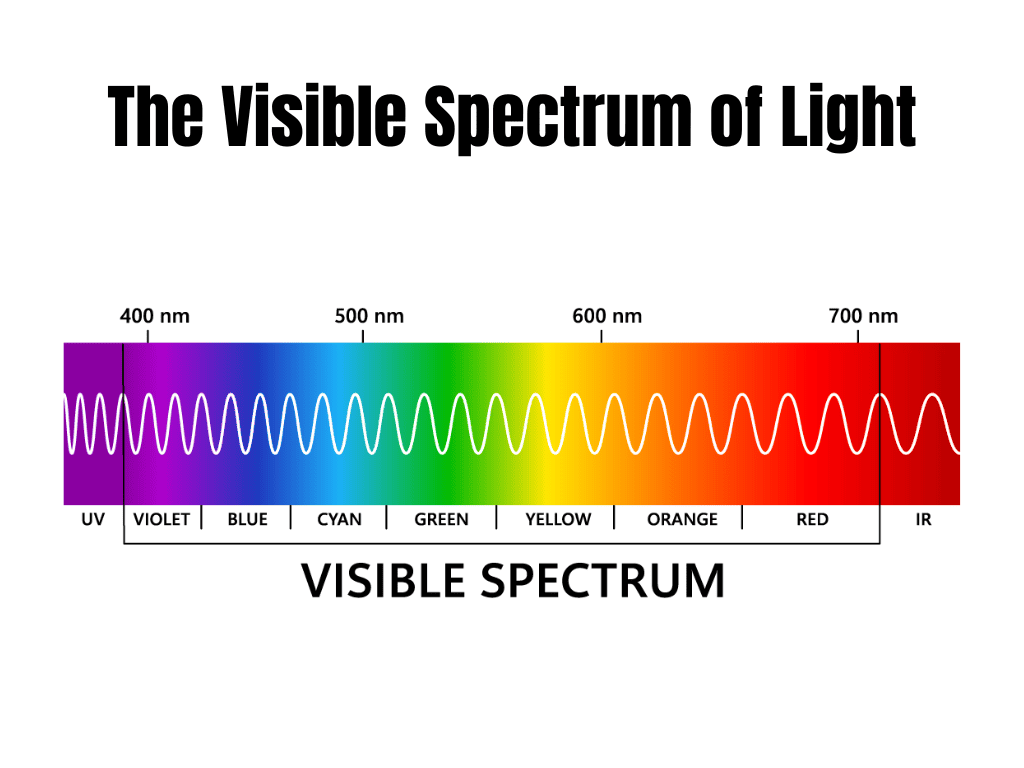
- Short wavelengths: the blue part
- Middle wavelengths: the green part
- Long wavelengths: the red part
The color we see when we look at an object is the light it reflects back to us, essentially a blend of the additive colors it doesn’t absorb.
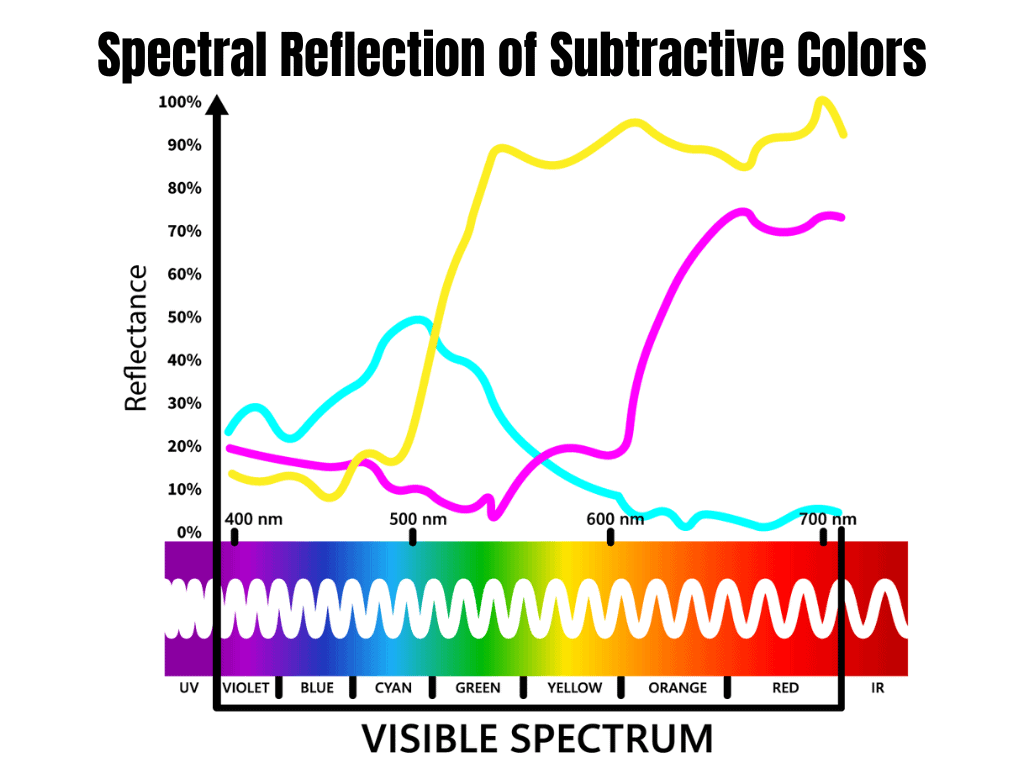
Let’s consider a lemon. A lemon absorbs most of the wavelengths in the blue part of the spectrum, reflecting the other two parts between 570 and 700 nm. This range represents the red and green parts of the spectrum. In this case, red and green light produce yellow.
Subtractive color starts with white, which covers all the wavelengths of the spectrum of colors. When you add pigments (like paint or ink), they absorb some colors and reflect others, changing the color we see. This is called subtractive because it removes some colors of light.
In order to see black, your pigment must absorb the entire spectrum of visible light, which is almost impossible because there is no pure black on Earth.
The purest black material on Earth is Vantablack. This is the blackest black because it absorbs 99.9923% of light. VANTA stands for vertically aligned nanotube arrays.
What Are the True Subtractive Colors?
When it comes to colors, we often think about the vibrant hues that fill our lives. But have you ever stopped to wonder how these colors are produced? That’s where subtractive color comes into play.
Subtractive color is a fascinating concept that involves mixing pigments that subtract light to create color.
In art classes, you learned that the primary subtractive colors are red, yellow, and blue. You still learn that in art schools today because some teachers have a limited understanding of optics and color theory.
The truth is that when artists started applying color theory, the true primaries (CMY) were not available as pigments, so they replaced them with red, yellow, and blue (RYB).
The true subtractive colors are cyan, magenta, and yellow.
They receive the name “subtractive” because each color actively absorbs one of the primary light colors, specifically its complement: Cyan absorbs Red, Magenta absorbs Green, and Yellow absorbs Blue.
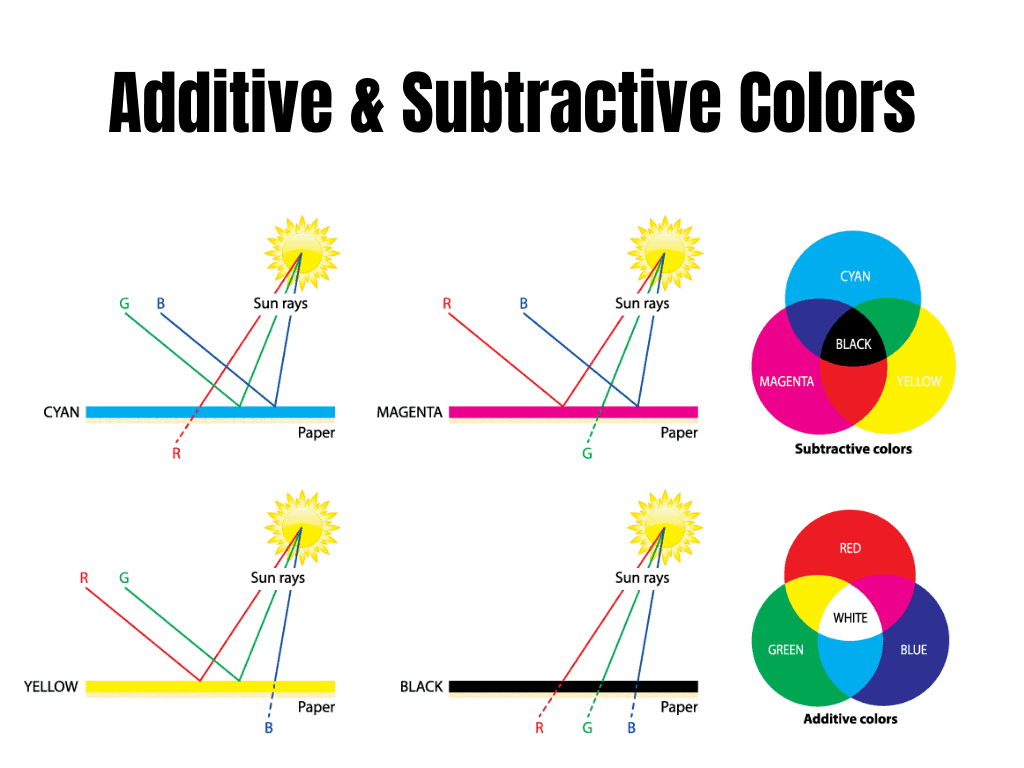
Since each absorbs one primary color of light, it reflects the other two: Cyan reflects Blue and Green; Magenta reflects Red and Blue; Yellow reflects Red and Green;
So each subtractive colour absorbs or subtracts its opposite color from white light.
- Cyan is the opposite of Red; thus, Cyan absorbs Red and reflects Green and Blue, which combine to make Cyan;
- Magenta is the opposite of Green; Magenta absorbs Green, reflecting Red and Yellow to make Magenta;
- Yellow is the opposite of Blue. Yellow absorbs Blue, leaving Red and Green to make Yellow;
By combining two subtractive primary colors, you get additive primary colors. So, CMY goes hand in hand with RGB.
- Yellow + Magenta = Red
- Yellow + Cyan = Green
- Magenta + Cyan = Blue
By combining two additive primaries, you get a subtractive primary.
CMY Color Model
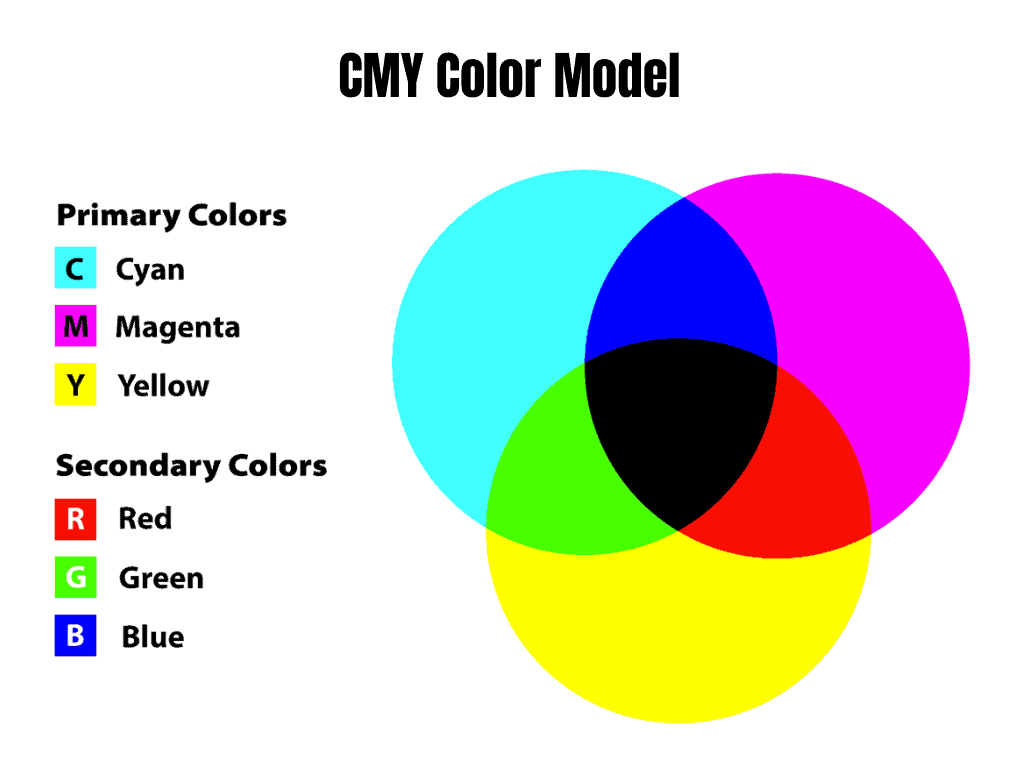
CMY is a subtractive color model that serves as the basis for the CMYK model used in printing. This acronym stands for cyan, magenta, yellow, and black.
In the CMYK color space, K stands for black and is used as an additional color because mixing the subtractive primary colors does not produce a deep black but rather a dark, muddy brown, or brownish-gray color.
As you can see, the primary subtractive colors don’t fully absorb light, preventing reflected color wavelengths. This is another reason why the printing color model includes black as a fourth compensating pigment.
CMYK model printers work with reflected light. For instance, when printing cyan on white paper, the ink absorbs the red light and reflects green and blue, which merge to produce what we see cyan.
The primary colors of CMY are cyan, magenta, and yellow. Each one absorbs its complementary additive color, reflecting the other two.
The opposite of cyan is red, so cyan absorbs red and reflects green and blue, which makes cyan.
The opposite of magenta is green. Thus, magenta absorbs Green and reflects red and blue, which combine to make magenta.
The opposite of yellow is blue. A yellow pigment absorbs blue, reflecting red and green to make yellow.
Combining pairs of two primary subtractive colors produces the primary additive colors: red, green, and blue. They are also known as the secondary subtractive colors.
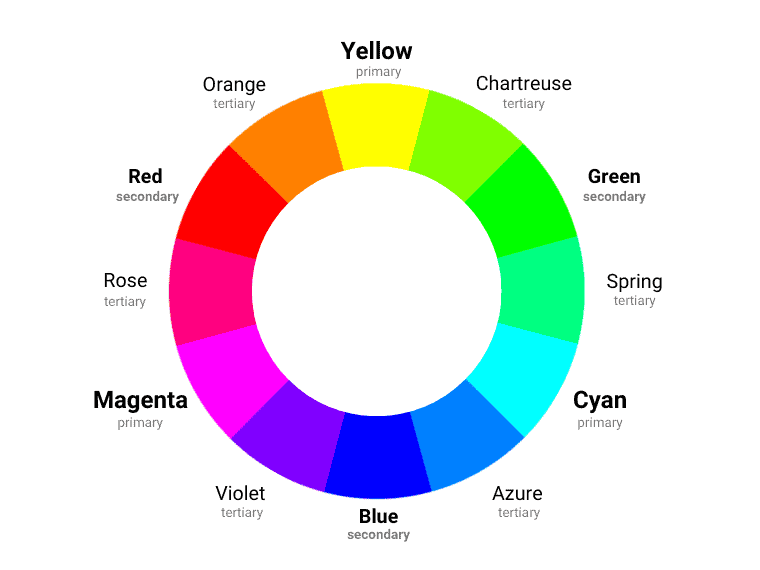
Once you combine them, they act as filters for the colors of light, absorbing and reflecting partially or entirely the additive colors.
Yellow + Magenta = Red
In this case, the yellow pigment is the first filter, which absorbs blue light and transmits red and green light. Magenta, the second filter, subtracts green light, and reflects red light.
These primary color combinations result in the same colors regardless of which filter is first.
In subtractive mixing, the first pigment absorbs or subtracts one of the additive colors, reflecting the other two interacting with the second pigment. Among these two colors of light, only one is reflected.
Yellow + Cyan = Green
Yellow absorbs blue and reflects both red and green. Cyan absorbs red and reflects blue and green light. Because yellow absorbs blue, only green light is reflected. So, the only color they both reflect is green, which is obtained by the subtractive synthesis of blue and red.
Magenta + Cyan = Blue
Magenta absorbs green light, reflecting blue and red light. In addition, cyan absorbs red light and reflects blue blue light.
RYB Color Model
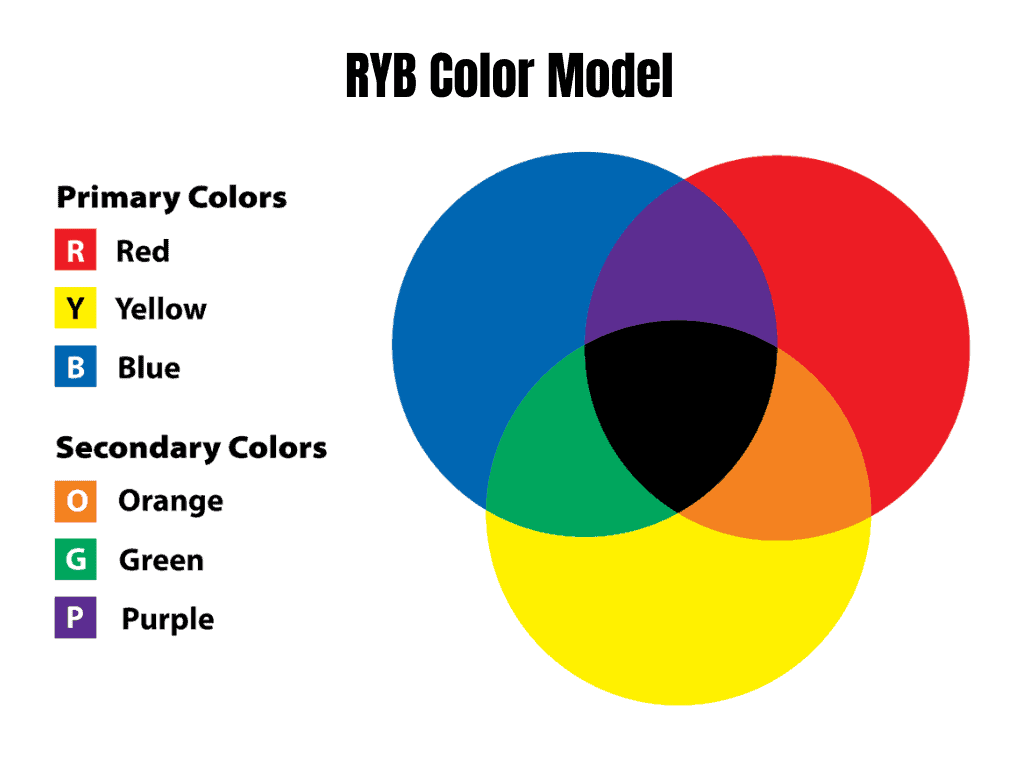
RYB is a subtractive color model used in traditional art. Its primaries are red, yellow, and blue. Mixing two primary colors creates secondary colors: green, orange, and purple.
RYB color model is outdated due to the broad absorption spectra of blue and red. For example, when you mix red and blue, they absorb a broad range of light wavelengths.
This explains why some of the mixtures are too dull. There is too much loss in saturation.
Mixing pigments with broad absorption spectra, such as red and blue, leads to the absorption of a wide spectrum of light, resulting in muddy colors.
However, if you use red, yellow, and blue as primaries, you can do all shades, but you can’t do all colors.
Why Do Printers Use CMY as Primary Colors Instead of RYB?
Printers use ‘Cyan’ and ‘Magenta’ instead of ‘Blue’ and ‘Red’ because they work better for subtractive color mixing.
Printers use this method, contrasting with screens like TVs and smartphones, which employ additive mixing.
In subtractive mixing, inks, dyes, or pigments absorb certain colors of light and reflect others. When light hits a white piece of paper, it reflects most of it. But when you add ink, say yellow, it absorbs the blue light and reflects the rest, making the paper look yellow.
If we mix blue and yellow, we should get green. However, blue absorbs too much light (both green and red light), leaving a dark, dull green instead of a bright one.
This is because the blue’s absorption spectrum is too broad. Thus, blue absorbs the green and red parts of the visible spectrum, while cyan absorbs only the red part.
There is a similar situation for red.
Red absorbs a wavelength range that is too wide, overlapping blue and green, not just green as it should.
Things work better if we replace blue with cyan and red with magenta. Cyan absorbs only red light, and magenta absorbs only green light. When you mix cyan and yellow, you get a bright green because cyan absorbs red, and yellow absorbs blue, allowing only green light to reflect.
Magenta and cyan have narrower absorption spectra than red and blue, making them better choices. With cyan, magenta, and yellow, each primary absorbs one-third of the light spectrum, leading to brighter and more accurate colors.
While cyan, magenta, and yellow are great for subtractive color mixing, it’s important to note that even these colors can’t create every possible color. You can make all hues but not all shades and tints. This limitation applies to both additive and subtractive color mixing.

